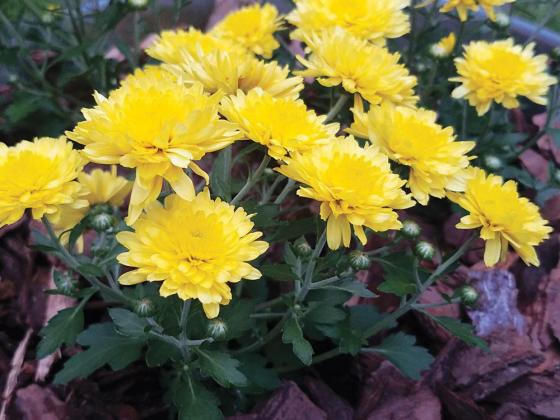
Heather Kirk-Ballard / LSU AgCenter horticulturist
Chrysanthemums, commonly known as mums, are synonymous with fall. Throw in some pumpkins, corn stalks and a scarecrow, and you’ve got yourself the quintessential quartet of the autumn decorating palette. These fall-blooming perennials go with autumn like pumpkin spice to your latte and candy corn to your trick or treat.
Chrysanthemum means “gold blossom” in Greek, and the plants are native to Asia. They are thought to originally have been cultivated in China and have been in recorded history since the 15th century. Today there are more than 20,000 cultivars. Wow!
The Japanese are also devoted chrysanthemum growers; they hold a sacred festival annually honoring the flower and its rich history. The Japanese emperor sits on the Chrysanthemum Throne, and the Imperial Seal of Japan displays a chrysanthemum. Closer to home, Col. John Stevens imported mums from England in the late 1700s, bringing them onto the American horticultural scene.
All over the world, Nov. 1 is celebrated as All Saints’ Day. Also known as All Hallows’ Day, it is preceded by All Hallows’ Eve (Halloween) and is known among Catholics as the Feast of All Saints. Finding its origins mainly in France, it is traditionally known as La Toussaint — French for All Saints’ Day. This day is celebrated in many European countries as well as the United States.
This day is a time for families to pay respect to their deceased relatives. Across the parishes of Louisiana, you often can see families gathering at cemeteries to clean and decorate tombs. Families traditionally bring fresh flowers — especially mums — to the graves of departed loved ones because they are available that time of year.
Mums are perennial flowering plants that are divided into two groups: garden-hardy and exhibition types. The names indicate their use in the landscape and for their showy blooms, respectively.
The garden-hardy types are used in landscape settings and are profuse bloomers. Flowers come in several forms such as pompons, buttons and daisy-like. There are many hybrids and thousands of cultivars, and they are available in an array of colors such as yellow, orange, white, purple, burgundy, peach and pink. The exhibition types are as their name implies — large-blooming, or spray types, that can be used in hanging baskets and other interesting forms.
The U.S. National Chrysanthemum Society divides the blooms into 13 categories including ray, disk, ogiku, pompon, spider form and anemone form, just to name a few.
With all these choices, it’s hard to know where to start. Go for what you like, but please practice restraint when purchasing mums. Consider the amount of bloom time you want to get from your plant. The best selection for an extended flower time is a plant that is full of buds that are not yet open. It is hard not to buy the fully blooming plants — I know.
If you are looking for that instant gratification and want plants blooming for a gathering now, go for those plants in full bloom. Otherwise, bite your lip and buy the one with buds that have not yet opened. When purchasing garden mums, be sure to consider varieties that will bloom in the early, middle and later parts of the season.
According to retired extension specialist Allen Owings, two-toned bicolor flowers have been recently introduced, and the Prophet series of garden mums is popular. The varieties include Jessica, Marilyn, Kimberly, Stacy, Tracy, Linda, Lisa, Lynn, Marilyn, Nicole, Cheryl, Allison and other feminine names.
For planting in the landscape, put in a well-drained, sunny spot, and make the spacing 24 inches apart to keep plants compact and dense. Use a complete slow-release fertilizer or liquid fertilizer after planting.
As with all bed plantings, to effectively control weeds, retain moisture and provide organic material such as a 1- to 2-inch layer of pine straw, pine bark mulch, leaf litter or other mulch. Because fall typically is dry in Louisiana, be aware that a lack of water on garden mums delays flowering and slows — and could ultimately stop — growth. This could increase susceptibility to disease and pest problems. It’s important to avoid overhead irrigation on mums and be sure to water around the outer root area of the plant (the dripline). Soaking garden mums at the base of each plant could result in stem rot problems.
Mums are like poinsettias, Christmas cactus, Easter lilies and other seasonal plants in that after the holiday ends, they are often tossed out when decorations get stored for the next year. However, you can keep mums going in the garden as perennial plants if you keep them evenly watered, but not waterlogged, through the winter, prune them lightly between late winter and mid-spring the following year and fertilize them lightly in the spring with a slow-release fertilizer.
Come fall, the shorter days will signal them to begin flowering again, and the cycle starts all over. Isn’t it great? I love the changing of seasons, even if in Louisiana our year often feels like just one long, hot summer.
